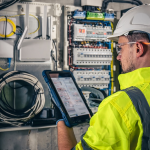Air travel has come a long way. From the introduction of the first commercial jet airliner to the digitization of ticketing, airports have always been at the forefront of technological advancement. Now, another revolution is taking place: the rise of smart luggage systems. Leveraging innovative technologies, airports worldwide are employing these advanced systems to enhance security and efficiency, positively transforming the passenger travel experience.
The Emerging Era of IoT in Airports
Internet of Things (IoT) is central to this transformation. IoT, when coupled with data and technology, has the potential to revolutionize airport operations, including luggage handling. This section will explore how IoT and data can transform baggage handling operations, leading to improved security and efficiency.
In parallel : Can AI-Powered Predictive Analytics Prevent Plant Diseases in Agriculture?
IoT involves interconnecting devices over a network, allowing them to collect, share, and analyze data. In the context of airports, IoT devices can be integrated into luggage systems to track and manage bags with unparalleled precision. By embedding RFID (Radio Frequency Identification) tags into luggage, these systems can monitor the location of every piece of baggage in real-time.
With a wealth of data at their fingertips, airports can monitor baggage handling operations in real-time, identify bottlenecks, and optimize operations. This level of insight can aid in reducing the frequency of lost or delayed baggage, a common pain point for travelers.
Also to discover : What Role Does Nanotechnology Play in Enhancing Food Packaging Safety?
Moreover, IoT-enabled luggage systems can facilitate advance security checks. Authorities can use the data gathered to identify suspicious baggage and conduct thorough inspections, dramatically enhancing airport security.
AI-Powered Luggage Handling: The Future of Travel
Artificial Intelligence (AI) is another key technology shaping the future of luggage systems. From automating baggage handling processes to predictive analytics for forecasting luggage volume, AI is proving instrumental in enhancing efficiency and security at airports.
Through the use of machine learning algorithms, AI-powered luggage systems can autonomously sort and transport baggage to the correct flight, reducing the chances of human error. This automation can significantly cut down the time taken for luggage processing, making travel more efficient for passengers.
In terms of security, AI can analyze data from luggage scans to detect potential threats. By learning from past data, the system can improve its accuracy over time, identifying objects and substances that pose a security risk with greater precision.
Biometrics: Redefining Passenger Experience
The integration of biometrics into smart luggage systems is redefining the passenger experience by streamlining luggage check-in and retrieval processes.
Traditional methods of checking in luggage and identifying it on arrival can be time-consuming and prone to errors. Biometric technologies such as facial recognition and fingerprint scanning can eliminate these issues. By linking luggage to a passenger’s biometric data, airports can expedite the check-in process and ensure that only the rightful owner can retrieve the luggage.
Biometrics also provides an additional layer of security by making it more difficult for unscrupulous individuals to tamper with or steal luggage. Consequently, airports that adopt biometric technology in their luggage systems can significantly enhance their security while also improving the overall passenger experience.
Contactless Technology: A Game Changer for Luggage Systems
The COVID-19 pandemic has emphasized the importance of contactless solutions, and the airport industry is no exception. Contactless technology is playing a vital role in reimagining luggage systems, making them safer and more efficient.
Contactless technologies, such as NFC (Near Field Communication) and Bluetooth, allow passengers to check in their luggage without any physical contact. They can use their smartphones to confirm their identity, drop off their bags, and even pay for additional luggage, all without interacting with a kiosk or staff.
In addition, real-time tracking apps enable passengers to monitor the location of their luggage on their mobile devices, reducing anxiety and improving the travel experience.
Security-wise, contactless technology offers significant advantages. Digital identity verification can reduce the risk of identity fraud, while real-time tracking can deter theft or tampering.
Conclusion
As you can see, the integration of smart technologies into luggage systems can vastly enhance security and efficiency in airports. By adopting IoT, AI, biometrics, and contactless solutions, airports can revolutionize the way they handle baggage, offering passengers a smoother, safer, and more enjoyable travel experience.
Advanced GPS Tracking: The Key to Operational Efficiency
In the ever-evolving world of air travel, advanced GPS tracking is making its mark as a comprehensive solution to streamline luggage handling. It’s a game-changer in boosting operational efficiency and revolutionizing the passenger experience at international airports.
GPS tracking incorporated in smart luggage systems allows for real-time tracking of each piece of luggage, from the moment it leaves the passenger’s hands until it reaches the final destination. This high level of visibility enables airports to monitor baggage handling operations and work proactively to mitigate any potential issues or delays.
The advantages extend beyond operational efficiency. With GPS tracking, passengers can also keep a tab on their luggage through a mobile application, assuring them that their possessions are safe and on the right path. This greatly reduces the stress associated with lost or delayed luggage and enhances the overall travel experience.
Moreover, GPS tracking can also play a critical role in airport security. In case of any suspicious activity or unexpected movement, the system can send real-time alerts to airport authorities, enabling them to take prompt action. This level of vigilance brings an added layer of security to the airport, making it a safer environment for everyone.
Cutting Edge IoT Solutions: Redefining Airport Management
IoT-based solutions are proving to be a key driver in the transformation of airport management. Leveraging the power of data analytics, these advanced technologies are enhancing the way airports manage baggage handling systems and improving the overall efficiency of airport operations.
By integrating IoT-enabled devices into the luggage handling systems, airports can collect and analyze a vast amount of data in real-time. This data can provide valuable insights into the performance of baggage handling operations, allowing airport management to identify potential issues and make informed decisions to optimize operations.
Moreover, IoT solutions can also help enhance airport security. By monitoring the movement and handling of luggage, the system can identify any irregularities and alert the security team, aiding in a swift response.
IoT-based luggage systems also contribute to a better passenger experience. Real-time updates about the status and location of their luggage give passengers peace of mind, allowing them to focus on enjoying their travel experience.
Conclusion
The future of air travel looks promising with the emergence of smart luggage systems. These advanced technologies are not just reshaping baggage handling; they are transforming the entire landscape of airport operations. From enhancing operational efficiency to boosting airport security, smart airports are leveraging IoT, GPS tracking, AI, biometrics, and contactless technology to revolutionize the passenger experience.
In an increasingly connected world, the adoption of these technologies in the aviation industry is a significant stride towards creating a safer, more efficient, and passenger-friendly air travel experience. As we move forward, we can expect these smart technologies to continue to innovate and redefine the way we travel.






